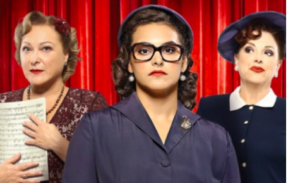The new biographical series by ERT, “Maria Who Became Callas,” which narrates the transformation of young Maria Callas from an awkward girl to the greatest diva of all time, didn’t impress Popi Diamantakou. Directed and written by Olga Malea, the series is based on research from the book “The Unknown Callas” by historian Nikola Petsalis-Diomidis.
In a critical social media post, the TV critic commented that the series missed the opportunity to be a significant artistic endeavor, calling it a lost chance for both Greek and international audiences. She pointed out that the production fell short of expectations for a series about Maria Callas’ life, even in her early years, describing it as a low-budget effort reminiscent of ERT’s productions from 30 years ago. The direction was deemed superficial, and the outdoor scenes were criticized as hastily executed, leaving a negative impression.
Her critique extended to the performances, mentioning Eleni Rantou as portraying a “caricature of a strict mother” in a somewhat comical manner. While acknowledging the efforts of other actors, such as Maximos Moumouris and Ioannis Papazisis, she considered them partially successful due to shortcomings in the script and editing. Special mention was made of the young Cleopatra Eleftheriadou, who, despite her talent, appeared to lack proper guidance, resulting in a one-dimensional performance.
Diamantakou’s Social Media Post in Detail:
“Maria Who Became… a Missed Opportunity”
“Even though the series portrays Callas during her early years in a poor, occupied Greece, ‘Maria’ by ERT doesn’t seem up to the task. The name Callas alone cannot add glamour to a poor production that resembles ERT of 30+ years ago.
It’s a shame because this was an opportunity for ERT to present a high-standard production, garner international attention, and outshine Hollywood and Jolie, who also struggled unsuccessfully for two hours to earn an Oscar. The direction is at best superficial (a pity, as we liked Malea’s work in ‘Our Best Years’). The outdoor scenes are so sloppy they provoke laughter.
The persistently narrow framing in exterior shots—presumably to avoid showing modern buildings—was stifling. The funniest part, I regret to say, was the choice of outdoor locations. The dreary little shrubs pretending to be natural scenery, always the same for various exterior scenes, looked like flowerbeds outside ERT. Was that what they were? Couldn’t they have used the National Garden, which looked the same during the interwar period?
Although Athens is a city that hasn’t preserved much of its history, there are still neighborhoods that could have served as interwar settings. If they didn’t know where to find them, they could have asked researchers. For example, MONUMENTA and Irini Gratsia have comprehensive records of buildings and areas.
The performances didn’t fare much better. Eleni Rantou simply plays herself, portraying a caricature of a strict mother in what are mostly comedic scenes. Should I assume she studied, as she should have, the letter Callas’ mother wrote to her—available at the Callas Museum on Mitropoleos Street—and came to the conclusion that this is what we’re seeing on screen? I don’t know what to say!
Maximos Moumouris was somewhat saved by his German-speaking skills and perfect accent. Ioannis Papazisis, playing baritone Magliveras, who later became Maria’s lover, also did a decent job, although he suffered greatly from the incoherent editing. This is where the real mess happened.
In particular, the sixth episode—where there’s a patriotic reference to the rescue of ancient statues by Greek archaeologists and where Magliveras supposedly played an active role—descended into chaos with the famous Cycladic figurine, the Harpist. The Germans attempt to steal it, Callas intervenes to stop them, grabs the figurine from its pedestal, and a child emerges from hiding in the pedestal. Then, the figurine reappears, only to be grabbed by a hand that emerges from the hiding place. The figurine disappears and reappears backstage during a scene at the Lyric Theatre, where Callas and Magliveras are singing. Magliveras almost chokes when he sees it… Clearly, some shots were lost during editing, causing the narrative to hiccup badly.
The very young Cleopatra Eleftheriadou, reportedly very talented with a beautiful voice of her own, seemed to lack clear direction on how to interpret Maria’s character. Sweet, smiling, and identical in every scene—whether in love, as a promising soprano on stage, or as the shy, inexperienced Maria—she came across as if everything just flowed past her effortlessly.
Yes, it is difficult, if not impossible, to make a film or series about the life of a legend—from Elvis and Monroe to Callas. However, it could have been turned into a well-made modern fairy tale, where truth plays a minor role in fiction, captivating both enchanted viewers and those who never got to know them (as in Kazantzidis by Tseberopoulos). It’s a shame for ERT—such good actors, so much effort, such a failure.”
ERT’s Official Synopsis of the Series “Maria Who Became Callas”
The series follows Maria through her relationships with the key figures of her youth: her mother, her Spanish teacher, her baritone lover, her pianist sister, and her German conductor. Each of them, impressed by her talent, has different plans for her future. Through a journey between love and eternity, Maria searches for someone who will love her for who she truly is, without conditions or demands. This lack of love drives her to develop her talent and cultivate the unique voice that remains a reference point and milestone in opera even today.
Ask me anything
Explore related questions





